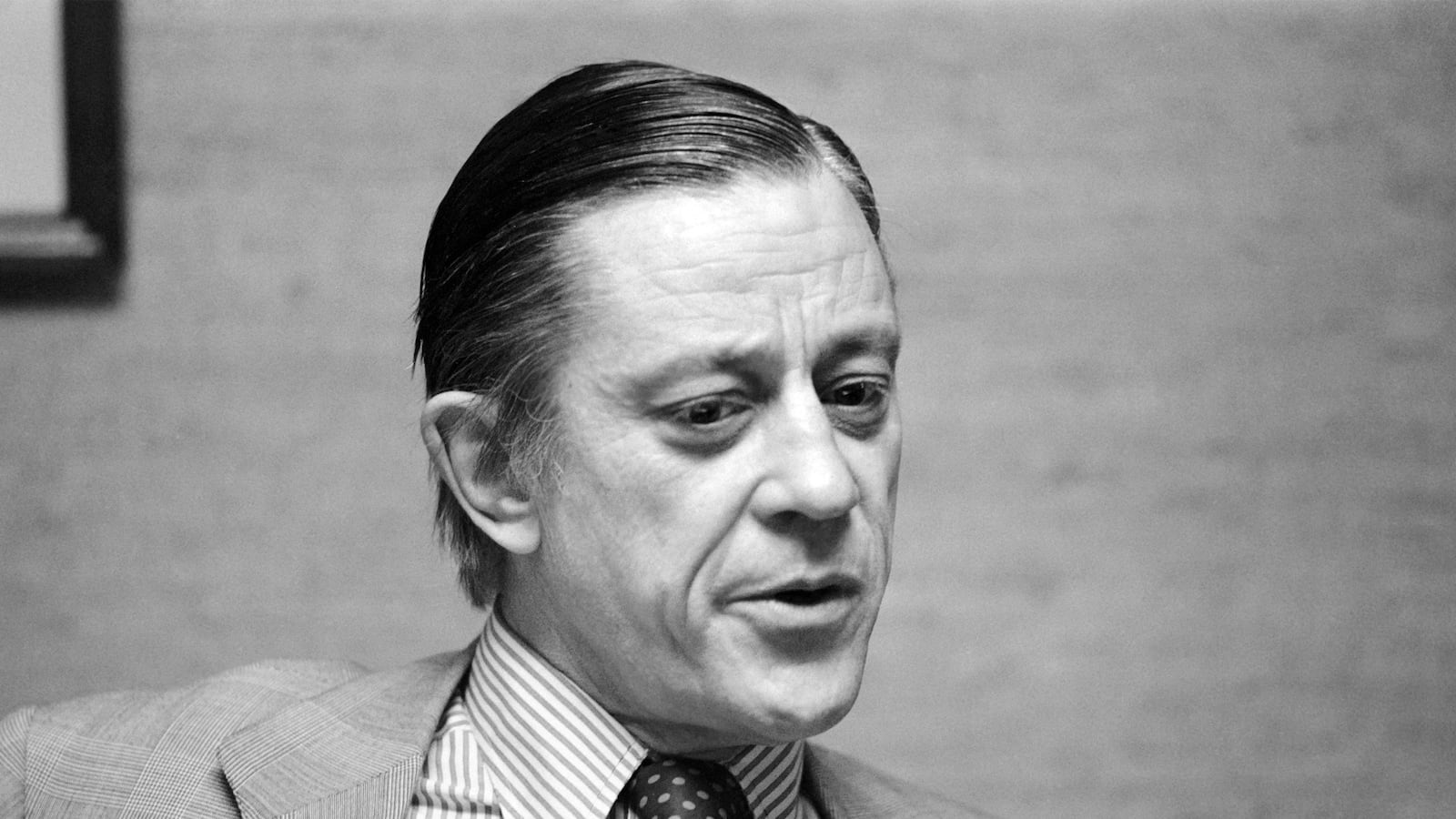On October 12, 1964, Mary Pinchot Meyer, the glamorous sister-in-law of Ben Bradlee and sometime lover of Jack Kennedy, was shot to death while walking along the C & O Canal in Georgetown. And in the hours that followed, the search for Meyer’s scandalous diary would find the future Washington Post editor in a race with one of the Cold War’s most legendary spies.
Bradlee, who died Tuesday at age 93, is rightly lionized as a master journalist. But he was also a key figure in a Washington establishment that arguably no longer exists—the kind of guy who advised presidents even as he reported on them, and counted some of the CIA’s top officers as personal friends.
The day Meyer died, these roles converged. After Bradlee had returned home from identifying Meyer’s body at the city morgue, he and his wife Tony received a call from the Tokyo-based artist and sculptor Anne Truitt. “She had been perhaps Mary’s closest friend,” Bradlee recounts in his memoir, A Good Life, “and after she and Tony had grieved together, she told us that Mary had asked her to take possession of a private diary ‘if anything ever happened to me.’ Anne asked if we had found any such diary, and we told her we hadn’t looked for anything, much less a diary.”
Bradlee and his wife began their search the next morning, only to find that someone else had been tipped off about the diary’s existence. Meyer’s door had been locked, but when Bradlee made his way in, he found James Jesus Angleton, the CIA’s counterintelligence chief, standing there in the living room. He, too, was looking for Meyer’s diary.
Asked how he had gotten into the house, Angleton, who was among other things an expert at picking locks, “shuffled his feet.” Angleton was a Washington social figure in his own right, and his wife Cecily had been close with Mary, who had been married to another high-ranking CIA officer. “We felt his presence was odd, to say the least, but took him at his word, and with him we searched Mary’s house thoroughly,” Bradlee wrote. After an exhaustive search, however, no diary was found.
Angleton is one of those people who will always be shrouded in mystery. To his detractors, he was a half-mad paranoiac who nearly destroyed the CIA in his obsessive search for a Soviet mole. He was also an unquestionably brilliant “master of the game” with highbrow literary interests—borrowing a line from T.S. Elliot, he memorably referred to the world of espionage as a “wilderness of mirrors.” He essentially invented the CIA’s counterintelligence operation and, until his fall from grace nearly a decade after Meyer was killed, was perhaps the most powerful man at the Agency.
“If [British defector Kim] Philby was, as many have called him, the spy of the century,” wrote historian Ron Rosenbaum, “James Angleton was the counterspy of the century.”
And here he was, on his hands and knees, fruitlessly searching for a diary with his friend Ben Bradlee, then the Washington bureau chief for Newsweek. Eventually they both gave up, and parted ways.
A few hours later, though, it occurred to Bradlee that Meyer could have kept the diary in her artist’s studio, which was actually located behind his house. “We had no key,” Bradley wrote, “but I got a few tools to remove the simple padlock, and we walked toward the studio, only to run into Jim Angleton again, this time actually in the process of picking the padlock. He would have been red-faced, if his face could have gotten red, and he left almost without a word.”
Meyer, in addition to being considered one of the great, sought-after beauties of Washington at the time, was involved with the artists’ scene in the city and its nascent counterculture. She was friendly with Timothy Leary, with whom allegedly she dropped acid. “Her paintings and paints in the palest colors, and simplest shapes, pretty much covered the studio,” Bradlee wrote. After about an hour, Tony found the diary.
It was slim, about “fifty to sixty pages,” according to Bradlee, and mostly concerned with her paintings. Ten or so pages of it, though, recounted her affair with President Kennedy, of which Bradlee and his wife had been completely unaware.
“To say we were stunned doesn’t begin to describe our reactions,” Bradlee wrote. The Bradlees and the Kennedys had been close, and while there were persistent rumors that the president cheated on his wife, Kennedy had always denied it to Ben even as he playfully flirted with Tony. Jackie Kennedy once joked to the Bradlees that Jack liked to call Tony his “ideal woman.” Jack, meanwhile, told Ben that he imagined the trouble-loving Mary must be “hard to live with.”
It all threw the Bradlees off Jack’s scent. Kennedy disliked having girlfriends, preferring one-off conquests instead, but made an exception for Mary Meyer. “I was truly appalled by the realization of the deceit involved,” Bradlee wrote. “I remembered, for instance, Kennedy greeting Tony often by asking, ‘How’s your sister?’, presumably including those occasions when he had just left her arms.”
Bradlee felt deceived by his friends but, “with both of them gone from my life, resentment seemed foolish.” In hindsight, the affair made sense to him: “They were attractive, intelligent, and interesting people before their paths crossed in this explosive way, and they remain that way in mind.” Coming to terms with their relationship, he wrote, was harder for Tony, who “had been kept in the dark by her sister and her friend.”
Mary Meyer had told her friend Anne Truitt that she had wanted the diary destroyed, and while Bradlee felt it was in some sense “a public document,” he agreed that it this was mostly a family matter, and went along with Mary’s wishes. Here, again, Angleton comes into the picture: In exchange for the diary, he promised Ben and Tony, he would destroy it. After all, who better to make something disappear than the CIA? And so Tony handed it over.
In 1976, Anne Truitt’s “troubled” ex-husband told the National Enquirer about the diary and Meyer’s affair with JFK. He said that the pair had smoked weed together on one occasion, and that the romance lasted from 1962 until roughly Kennedy’s assassination in 1963. Bradlee was on vacation when the story broke and, when reached by his own reporters for comment, told them off-the-record that the diary had been destroyed.
Except it hadn’t. A few years after the Enquirer story broke, Tony asked Angleton what, exactly, he had done with it, and Angleton admitted it was still in his possession. Tony demanded he give it back. Angleton complied, and Tony finally set the thing on fire “with a friend as witness.”
“None of us has any idea what Angleton did with the diary while it was in his possession, nor why he failed to follow Mary and Tony’s instructions,” Bradlee wrote. According to Truitt and Angleton’s wife, he burned “the loose papers” and “safeguarded” the rest of it, insisting that he had never been explicitly told to destroy it in its entirety.
The murder of Mary Pinchot Meyer was never solved, and is still a regular fixture of JFK conspiracy narratives. The police apprehended a man shortly after her shooting, but without much by way of evidence against him, he was acquitted at trail. Regardless, the psychic blow of Mary’s murder, coming so soon after his friend Jack Kennedy’s, had a profound effect on Bradlee.
“Even after more than 40 months in a shooting war, after years as a police reporter, and after more years covering shooting wars in the Middle East, violence as a fact of my life had begun only with Kennedy’s assassination,” he wrote. And now, after Mary’s “almost unbearable” funeral, he felt that “his own world was somehow threatened.”





